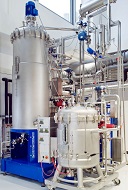
Biopolymers such as cellulose, hemicellulose, pectin or proteins have to be hydrolyzed into monomers (sugars and peptides/amino acids) before plant residues can be used as substrates in biotechnological production processes. Hydrolysis of plant materials can be achieved by suitable mixtures of hydrolytic enzymes after physic-chemical pretreatment.
Each microbial enzyme producer is specialized in the effective production of a specific group of these enzymes such as cellulases or hemicellulases. This makes various processes necessary to produce the aforementioned enzyme mixtures.
In this research project the production of hydrolytic enzyme mixtures for the hydrolysis of biopolymers in plant residues will be studied in a one-step process using co‑cultivation of different filamentous fungi. Suitable complementary enzyme producers will be selected, the interactions between these fungi in a bioreactor will be characterized and a novel process for production of ideal enzyme mixtures for the complete hydrolysis of plant residues will be established.
A broad mix of different monosaccharides and peptides will be formed after complete hydrolysis of plant material. Subsequently microorganisms with very broad substrate spectra should be used for the utilization of these monomers. Full conversion of the plant derived mixture of monomers will be finally studied using oleaginous yeasts for the production of high-value microbial lipids.
Publications
- Mittermeier F, Fischer F, Hauke S, Hirschmann P, Weuster-Botz D (2024): Valorization of wheat bran by co-cultivation of fungi with integrated hydrolysis to provide sugars and animal feed. BioTech 13: 15.
- Mittermeier F, Hafner N, Xypolia Vasila K, Weuster-Botz D (2023): Co-cultivation of Aspergillus niger and Trichoderma reesei enables efficient production of enzymes for the hydrolysis of wheat bran. Chem Ing Tech 95: 565-575.
- Mittermeier F, Bäumler M, Arulrajah P, García Lima JJ, Hauke S, Stock A, Weuster-Botz D (2023): Artificial microbial consortia for bioproduction processes. Eng Life Sci 23: e2100152.